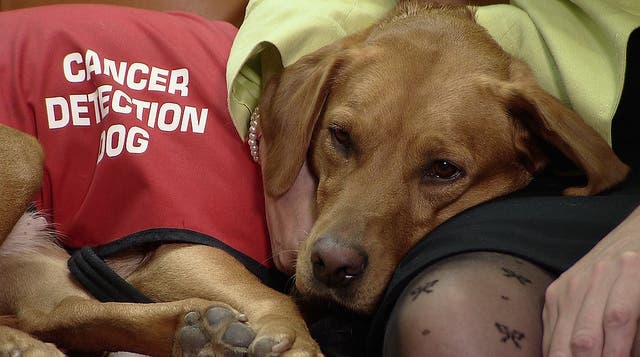
It’s remarkable — almost unbelievable — but one of the most accurate cancer diagnosing tool is man’s best friend. Studies have time and time again shown this to be true. One 2011 study found dogs can identify breast and lung cancer with a 95% accuracy compared to a biopsy. UK doctors working at the Milton Keynes hospital found canines are 93% effective at sniffing prostate cancer. Now, a new clinical trial will begin shortly in Japan to gauge how accurate dogs can sniff stomach cancer.
The cutest bio-detector
Some 6,000 Japanese individuals living in the Yamagata Prefecture will have their urine analyzed at a lab belonging to the Nippon Medical School, just outside of Tokyo. Trained dogs will then be tasked with identifying the cancerous samples.
It’s thought dogs achieve this feat by being able to discern odors released by cancerous cells which are oblivious to us humans. They are able to pick up a scent in a dilution of one to a thousand parts.
Given that so many studies have proven dogs’ propensity for sniffing cancer, why don’t we actually see them everywhere in a hospital, especially in those wards where cancer is diagnosed? Dogs have a sensitive smell but so do humans and like us, dogs need training too. Training a dog to accurately identify cancer odors can take years and somewhere around $45,000 per canine, according to Cynthia Otto, Director of the Penn Vet Working Dog Center at the University of Pennsylvania’s School of Veterinary Medicine. Otto says she’s often contacted by people from third world countries who’ve read various papers about cancer-sniffing dogs and got excited, not realizing how intense and expensive the training can be.
Another important caveat is that, again like humans, a dog’s sensitivity is susceptible to mood, diet, and even the owner’s behavior. A professional dog sniffer will also likely suffer if it doesn’t get to sniff cancer all day long.
“These dogs need the reward of finding people or they can get depressed. During the 9/11 search and rescue effort, emergency responders had to stage fake body finds so that the dogs could be rewarded. Cancer screening dogs need the same thing to avoid stress,” Sara Chodosh explained for Popular Science.
Nevertheless, given their staggering accuracy, there is value in training dogs to identify various forms of cancer even though they will never be used on a wide scale. Ultimately, everyone hopes that all of these clinical trials such as the upcoming one in Japan will single out the compounds the dogs are able to detect. Then, it’s only a matter of developing a device, perhaps fitted with a miniature spectrometer, that can mimic the canine’s cancer-sniffing ability.
“One of the largest misunderstandings we face is that people think we are trying to say that dogs are better than machines – we’re not,” said Claire Guest, a specialist in human and animal behaviour and the doctor responsible for the British research into cancer sniffer-dogs.
“There are already machines which act as ‘electronic noses’ that are designed to identify chemicals such as cocaine, and this is what we are trying to do with cancer.
“Of course, no dog is going to be 100 percent – but at the moment there is no machine out there that can do what the dogs are doing. Cancer detection is extr
Since 2013, a team from the University of Liverpool and the University of the West of England (UWE) in Bristol have developed a device “Odoreader” that can accurately detect bladder cancer by detecting specific volatile molecules found in the odor of urine, akin to an artificial dog’s nose. As more data is gathered, these devices will become more and more accurate. The dogs can then take a much-deserved break.






